Editor’s note: This article has been divided into two parts. Part 2 will be available next month.
In June 2023, we made the decision to leave behind our jobs, pause school for our two kids (then aged 11 and 7), and embark on an open-ended sailing adventure. We rented out our home in Victoria, BC, and flew to France to take possession of our Nautitech 44 Open catamaran, aptly named June, in the picturesque setting of La Rochelle’s iconic 5,000-slip harbor. Invigorated by the possibilities for adventure ahead, we also recognized the significant learning curve awaiting us in our new life on the water.
In the year leading up to our departure, we participated in Fleet, a well-structured program run by the Bluewater Cruising Association (BCA). This initiative offers aspiring offshore adventurers the opportunity to develop critical sailing skills. We honed our abilities in weather routing, rig checking, sail repair, engine maintenance, emergency planning, psychological preparedness for voyaging, and various other useful proficiencies. Coupling this training with our sailing experience and pre-departure ASA (American Sailing Association) course certifications, we felt well-prepared for the practicalities of sailing the open seas.
Still, despite our preparation, some aspects of our voyage proved less straightforward, particularly the practicalities of living aboard and moving our family from place to place.
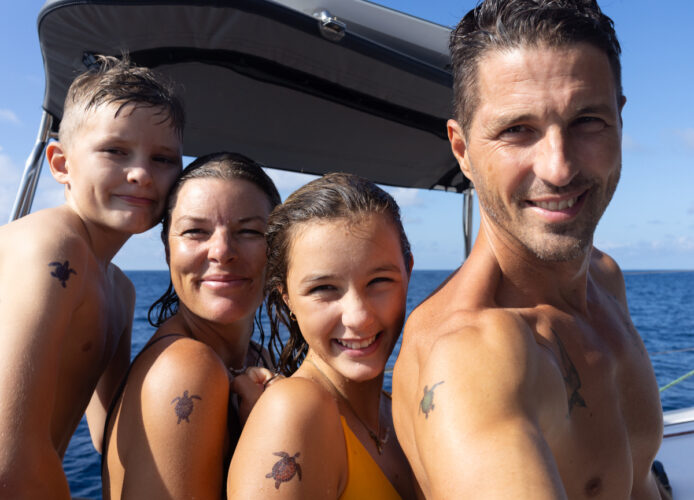
Our family, Remy, Natalie, Sonnen, and Peter Hunt, at our mid-ocean celebration: jumping off the boat at the Equator and earning our turtle tattoos as proper ‘shellbacks’
When a friend at BCA expressed trepidation about navigating immigration procedures across borders, we realized this was indeed one of the elusive knowledge areas that we would have to learn on the go. Our meandering experiences have taught us a lesson or two that we feel are worth sharing.
Here we share a personal account of the seas and borders we’ve crossed as a sailing family, highlighting the sometimes smooth, sometimes bumpy check-in and check-out processes we’ve encountered. By recounting our 2.5 years of experiences with international immigration in 23 countries, we hope to provide insight and alleviate any lingering doubts for fellow sailors planning their own far-flung adventures.
The Immigration Check-In and Check-Out Processes
The typical check-in process is relatively straightforward and generally follows these steps:
- Prior to arrival, ensure you are flying both the country’s flag and the Q flag to indicate that you haven’t yet checked in.
- Use online resources like Noonsite.com and NoForeignLand (the website and/or the app) to look up local immigration processes, which can vary from country to country.
- Confirm that you are arriving at a port equipped for immigration processing.
- In some countries, you will need to call ahead to notify the immigration office of your imminent arrival.
- Note that once you arrive and drop anchor or pull into a marina, you cannot leave your boat until the check-in has been completed. Usually, you must visit the local immigration office, though sometimes officers will come to your boat to process your visas. Customs officers may also want to search your boat for foreign fruits, vegetables, and contraband.
- Have passports and boat registration documents readily available. If checking into a marina, boat insurance documents are also usually required.
- You may be required to show a Zarpe (check-out form) from your last port, so have that on hand.
- Sometimes, only the Captain is required to be present for check-in and check-out.
The check-out process is similarly uncomplicated:
- Visit the local immigration office or arrange for immigration and/or customs officers to board your boat as per local protocol (sometimes requiring crew members to also attend in person).
- Ensure you receive a copy of the Zarpe to keep on hand for your next port of entry.
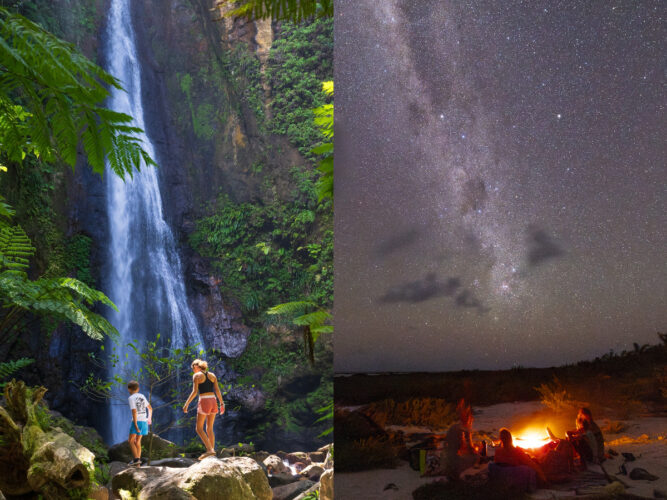
Left: Exploring hidden waterfalls in Dominica – border crossings can be stressful, but the rewards are pure adventure; Right: Magical nights spent cooking over an open fire, under a canopy of stars – one of sailing’s simple luxuries.
Setting Sail: Navigating Europe and the Complexities of the Schengen Zone
Sailing through Europe is generally straightforward, yet certain regions present unique challenges, particularly regarding the Schengen Zone. For non-European sailors, like Canadians, the visa rules require careful planning. Canadians receive a 90-day visa upon entering the Schengen Zone, allowing them to stay for up to 90 days within a 180-day period from their first entry.
We arrived in France in mid-June, aiming to reach the Canary Islands for our Atlantic crossing by early November. Anticipating that we might need more time in the Schengen Zone than standard visitor visas allow, we researched our options before our arrival.
We learned that applying for a long-stay visa could complicate our tourist status and potentially subject us to pay VAT on our boat, which we wanted to avoid. Exiting the Schengen Zone for 90 days to reset our visa period was impractical due to our schedule, which included hosting visitors and completing boat work in Spain.
Through another sailing family facing the same Schengen dilemma, we learned about a little-known reciprocal agreement between Canada and many European nations. This accord potentially grants Canadians an additional 90 days beyond the standard tourist visa – at least in theory. Despite verbal confirmations from embassies and vague documentation from Spain, we couldn’t secure reliable formal confirmation of this agreement.
Ultimately, we decided not to gamble on the bilateral agreement. Instead, we managed our time in the Schengen Zone by sailing 450 nautical miles east from Mallorca to Tunisia, spending several weeks outside the zone. Although this didn’t reset our 180-day period, it preserved some of our remaining Schengen days, crucial for our stop in the Canary Islands before our mid-November Atlantic crossing.
Tunisia, with its vibrant medinas and the ethereal allure of its salt flats, deserts, and date groves, became an unexpected highlight of our journey; we were captivated by its beauty and charm.
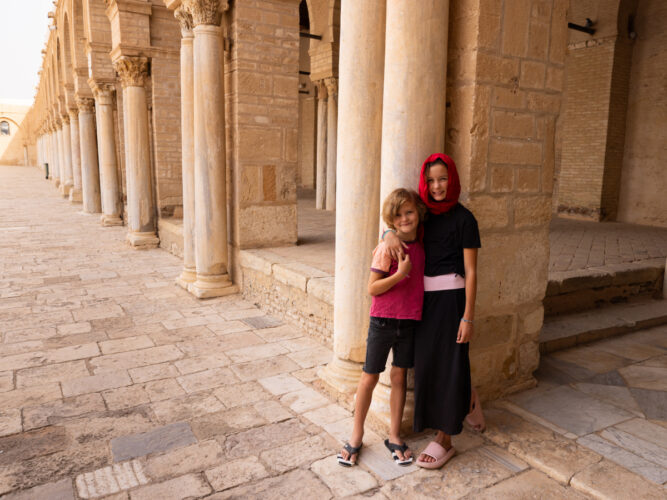
Tunisia turned out to be an unexpected favourite – rich history, vibrant markets, and the warmest of welcomes along our journey.
Be Prepared for the Unexpected: Some Entries Are More Colourful Than Others
The Mediterranean waters between North Africa and Europe are a high-traffic exit zone for immigrants fleeing hardship and violence as they seek a better life in Europe. Unfortunately, human smugglers exploit these vulnerabilities, conducting frequent and perilous operations over water.
With this in mind, we remained vigilant as we approached Tunisia. We were aware of the tense climate surrounding illegal immigration, including a recent incident involving two French nationals who mistakenly entered Algerian waters on jet skis from Morocco, and were shot by Algerian authorities. To avoid any similar mishaps, we navigated carefully around highly militarized regions, including Algerian waters.
Around 02:00h, as we sailed toward what appeared on radar to be a fishing vessel off the Tunisian coast, we altered our course to avoid it. Suddenly, the object seemed to pursue us. With no radio response or AIS signal, it was clear we were dealing with something other than a legitimate vessel. We quickly powered ahead with our engines.
The unidentified vessel continued its approach, soon blinding us with a spotlight and shouting in Arabic. A light revealed several armed men on the deck, who finally asked in English, “Who are you?” to which we responded, “Who are YOU?” Confusion gave way to relief when we realized the vessel was part of the Tunisian National Guard patrolling for human smugglers. We later discovered that our AIS transmit function was not working consistently, which certainly had caused, or at least intensified, the situation. After confirming our status as a Canadian tourist family, they took our details and bid us goodnight, disappearing back into the darkness. Neither parent slept again until we reached the harbor safely the following morning.
This vivid encounter highlights the importance of understanding the geopolitical situation in the waters you enter. Resources like Noonsite.com and NoForeignLand, as well as WhatsApp chat groups for sailors, can provide invaluable information. It’s crucial to be aware of potential risks, such as illegal immigration operations along northern Africa and the Eastern Mediterranean, piracy in Central and South America, unmarked fishing operations in various regions, and the presence of heavily militarized national authorities. Ensuring that your AIS is properly transmitting is clearly also important!
Security Checks and Contraband Goods: Navigating the Intricacies of Yacht Entry
In regions with less yacht traffic or where there are specific geopolitical concerns, security protocols can be more stringent compared to major tourist destinations. This was our experience in Tunisia and in Morocco, where our check-in and check-out processes involved a team of armed personnel, including police, military, and immigration officials, boarding and searching our boat. In Morocco, this even included a specialized sniffer dog seeking illicit drugs or trafficked humans.
To ensure a smooth check-in, familiarize yourself with lists of prohibited items, which can vary widely from country to country.
In Tunisia, we were aware that drones were not allowed, so we left ours with a friend in Mallorca. However, we were surprised when officials also enquired about our satellite communication devices. We showed them our backup IridiumGo system, which they confiscated for the duration of our stay, though they surprisingly had no issue with our mounted Starlink system.
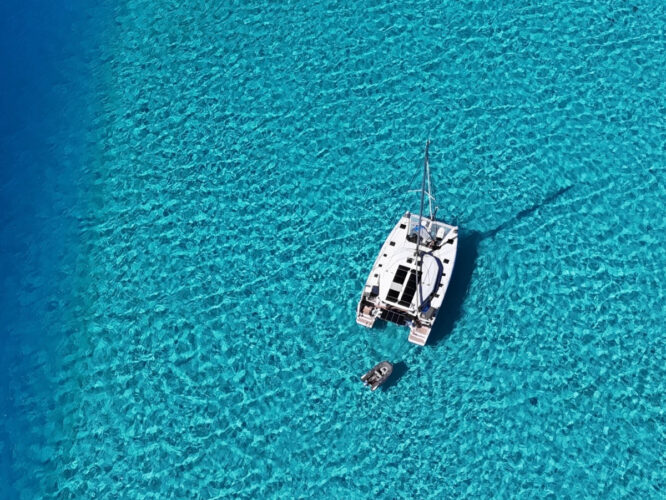
Drones are great for photos but are not allowed in Mallorca. Here we are tucked away on the shallow sand shelf behind an atoll reef – the perfect perch.
Fresh produce, honey, eggs, dairy, and meats are often examined and often prohibited, as nations seek to protect their local agriculture from introduced pests and diseases. We often use up our remaining fresh fruits and vegetables ahead of arrival if we know this to be the case, or chop and freeze them.
Not All Ports Are Created Equal: Check-In at Major Entry Points
After a brief respite in Mallorca following our time in Tunisia, we set sail for Morocco. This enchanting country, similar to Tunisia, allowed us to pause our Schengen clock while we explored its fragrant and colorful markets, a true ode to cultural richness.
When planning a sailing journey, ensure that the ports you intend to enter or exit have the necessary facilities for processing visitor visas. Not all ports are equipped for this, and arriving at an ill-equipped port can lead to unexpected delays or even denial of entry.
We learned this lesson firsthand after leaving Morocco enroute to the Canary Islands. We needed to make a quick stop in Tarifa, Spain, to pick up a supplementary house battery that had been shipped there. Our straightforward plan involved crossing the Strait of Gibraltar, a brief pause in Tarifa (about 25km west of Gibraltar), and then continuing to the Canaries. However, this leg proved to be one of our more memorable mornings and immigration experiences.
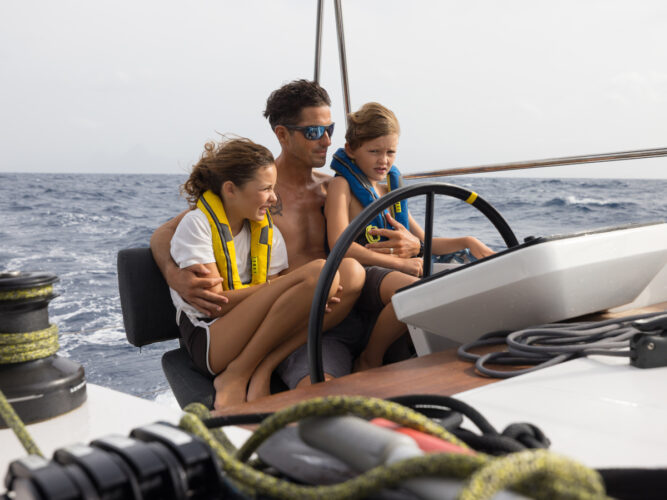
Long ocean passages leave plenty of time for dreaming, teaching, and just watching the sea.
Our day started with a mayday call from another sailing vessel that had been attacked by orcas and sunk less than an hour behind us, after leaving from the same port. Thankfully, the crew was rescued by the Moroccan Coast Guard. This was something we had not been expecting so early in the orca migration season and put us on high alert. High winds and rough seas also made for a swift but tense crossing.
Upon our arrival in Tarifa, we encountered significant delays and confusion after contacting the port authority; Tarifa is not a typical immigration processing port. We were directed to dock alongside a cement wall behind a Coast Guard vessel and instructed to wait there. To our surprise, we saw police officers and Coast Guard officials gathered around a body on the deck of the moored coast guard vessel next to us, and we learned that this was the casualty from a drug bust that had occurred just an hour earlier. The kind officers suggested we keep our kids from witnessing the unsettling scene if possible.
After some confusion, we were granted permission to check in and out, involving a long walk to be processed by unprepared immigration officials. We were also allowed to navigate through the city’s checkpoints on foot to retrieve our battery and return to the boat, passing a sizable pile of confiscated drugs awaiting police handling. This experience vividly reminded us of the unpredictability of sailing and reinforced the point that if practical, it’s best to arrange check-ins and check-outs at high-traffic immigration checkpoints.

Some of our favourite moments happen around the table – sharing slow meals by lamplight.
Stay tuned for Part 2 of this article, which contains more valuable Immigration tips, as well as more of June’s adventures. You can follow The Hunt Family’s journey on Instagram @sailing_june, or reach out to them directly for any follow-up questions.


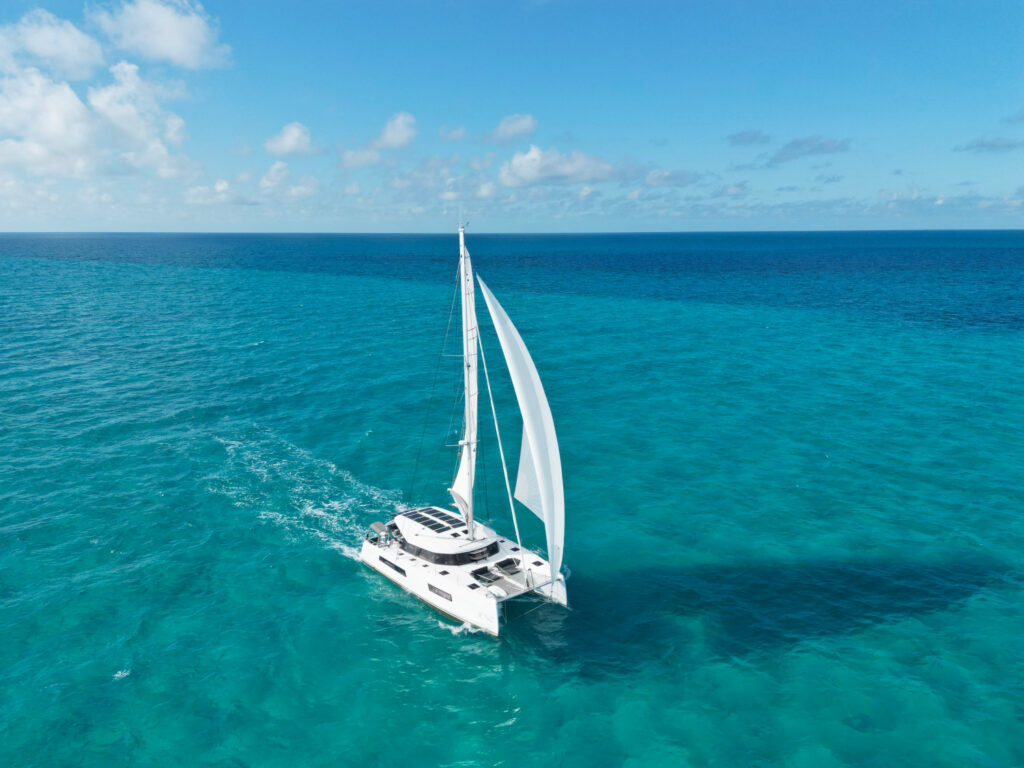
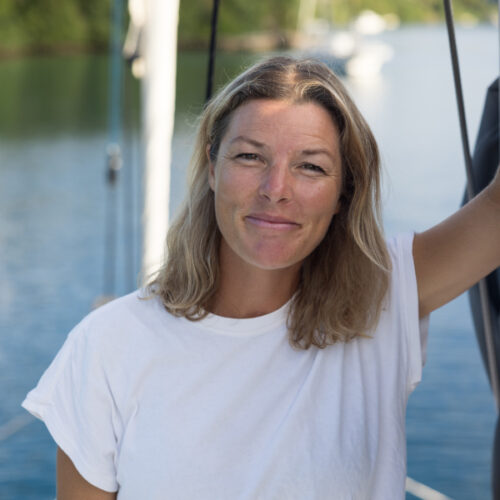



Excellent article! I’ve copied and pasted a lot of this into my own notes. Great info. Thanks!
Excellent information and evocative photos! Wishing you continued adventures of the good kind…although the not-so-good adventures often make the best stories! Thanks!